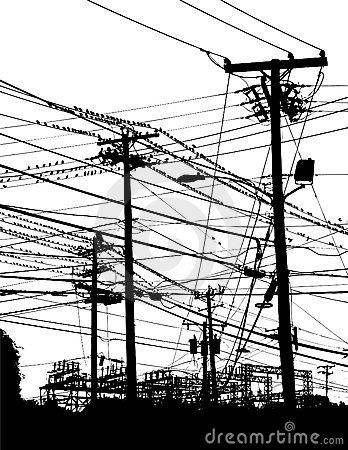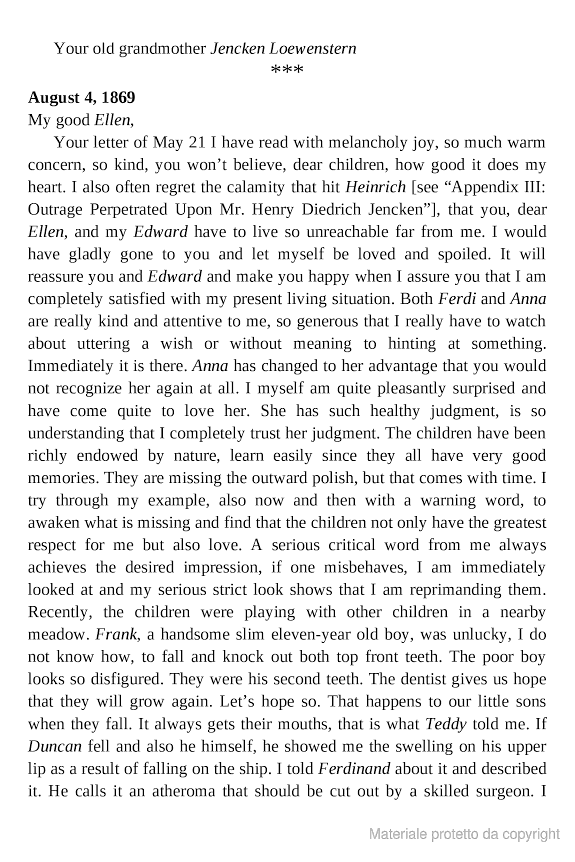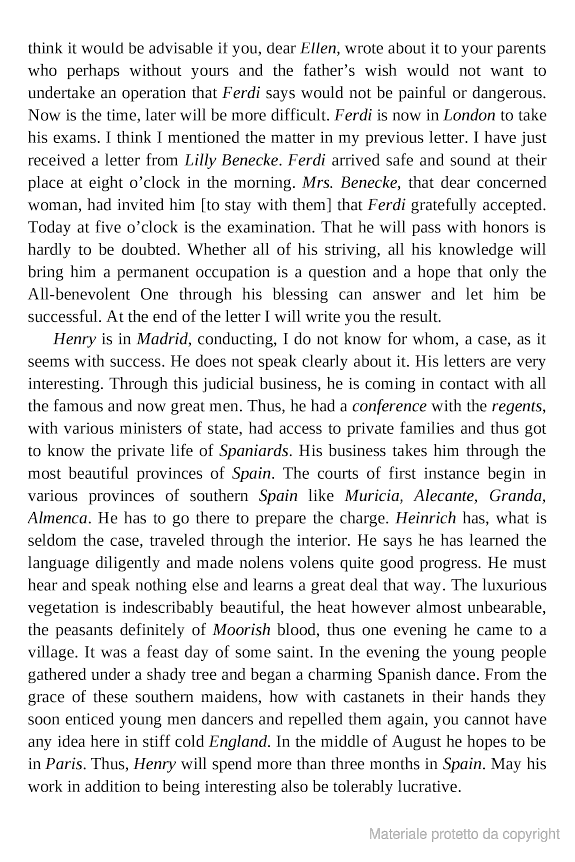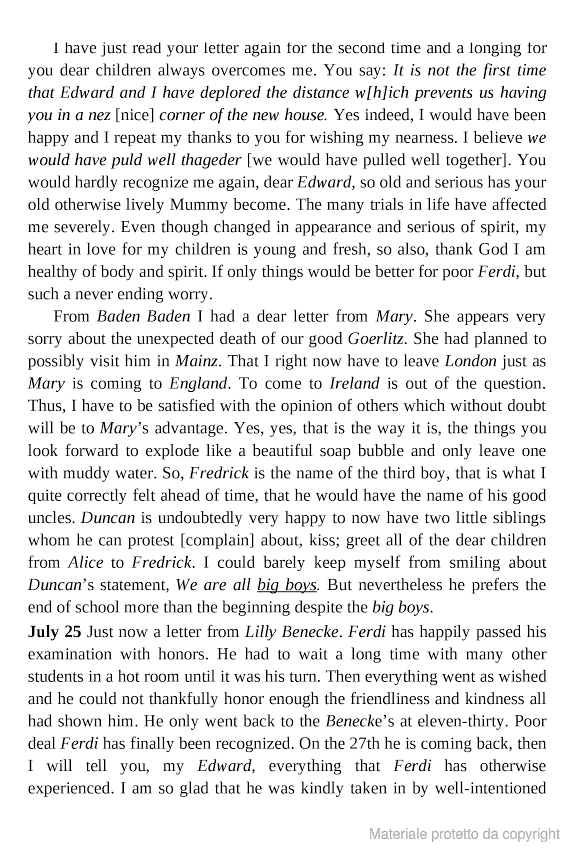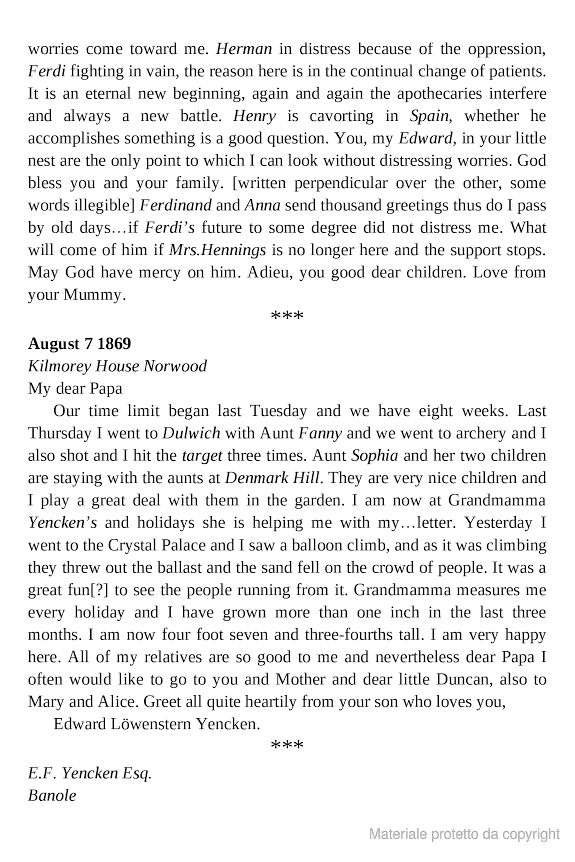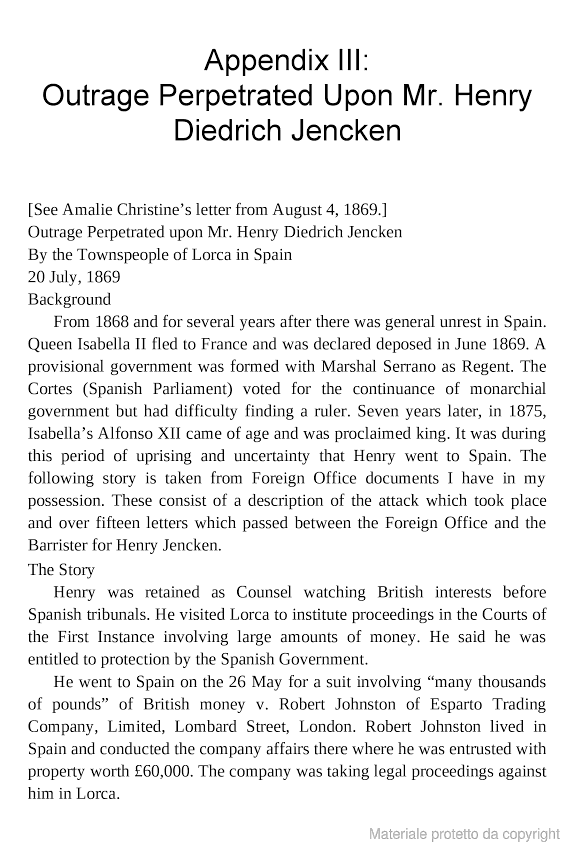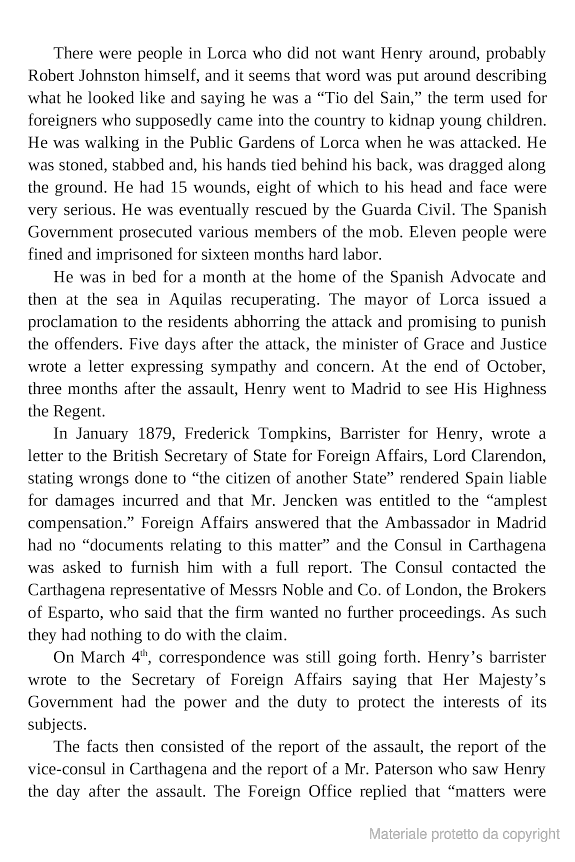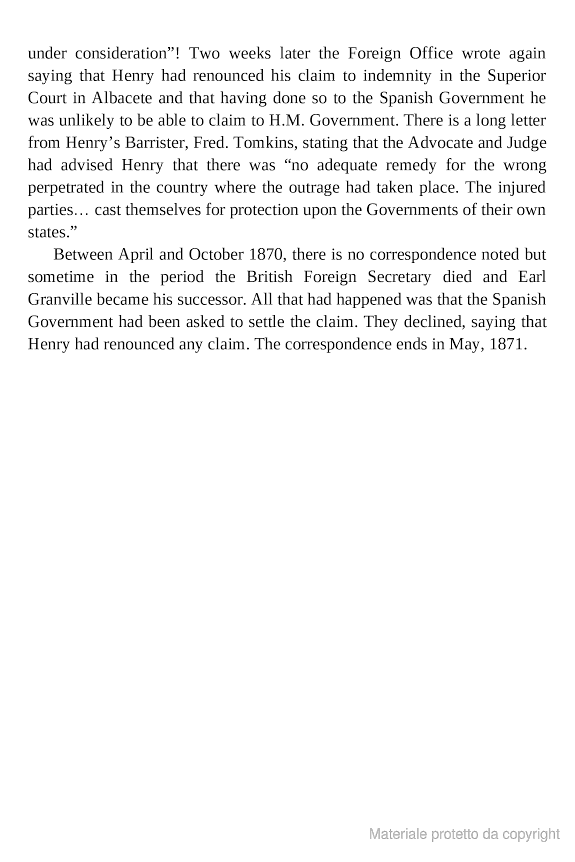English Vampire in Spain December 27, 2013
Author: Beach Combing | in : Modern , trackbackThis article comes from the later 1860s and describes the misfortunes of an Englishman who the locals decided was a Vampire. You have to cross the straits of Gibraltar and probably the Sahara to get this kind of incident today: memories of that fine Luise White book Speaking with Vampires. Lorcea is Lorca in Murcia. See the final spelling and other sources consistently refer to the town as Lorca.
Mr. H. D. Jencken writes from Lorcea (an ancient Moorish town in Spain) on August 7, a detailed account of the murderous attack upon him at that place on the 20th July. This attack was made under the most extraordinary pretext that he was one the suspected ‘Tios del Sain,’ child-stealers, to whom reports have imputed the horrible crime of catching and butchering young children for the purpose of using the fat of their entrails to repair the telegraph wires.
Telegraph wires?!
On the night in question, he says, I had strolled into the Paseo, or public walk, the ordinary evening promenade of the townspeople, and sauntering down the main road that runs at a right angle to the tree-sheltered walks the Paseo, was met by a woman leading a child by the hand, whom I greeted with the customary salutation ‘Buenes tardes,’ which she returned in the usual manner, when suddenly she turned round, and crying ‘Antonio,’ ran in the direction of some small houses fifty yards distant.
Mr Jencken had no idea the rain of fire that was about to pour down upon him.
As had no idea that the cry of alarm referred to me, I slowly sauntered back to the Paseo, but before I had proceeded 100 yards I noticed three men following me; instantly they closed in upon me, and commenced a most desperate attack upon my person. For the first two or three minutes I successfully warded off the thrusts made at my stomach with long knives (the usual mode of Spanish attack), when one of the men doubling upon me, struck me a furious blow on the back of my head with a stone; I staggered forward and sunk upon my knees; but, still retaining my senses, warded off several thrusts of the knives aimed at my throat and chest, receiving the same time severe wounds on my face and hands. One thrust actually penetrated my cheek and broke the bone of my upper jaw. Regaining strength, I sprang to my feet and ran for about 100 yards in the direction of the Paseo. By this time crowd had collected, for the cry ‘Tio del Sain’ had been raised by the assassins, when a terrible blow upon my left temple was inflicted and a second stone hurled at my head. I fell flat upon my face, when the crowd instantly seized me by the beard and hands, and in this manner dragged me along the road for some distance with such violence that the back of my watch (a gold hunter) was literally ground off.
Before we get to the climax of this incredible story it might be worth asking who a Tio del Sain is. The only source we’ve been able to consult describes a Tio del Sain as a ‘Grease Monger’: Tio is ‘uncle’ or at least in modern Spanish ‘guy/chap’ and sain Beach has been unable to relate to any Spanish word: Satan in the south? Anyway back to the misfortune of Mr Jencken. The ‘volunteers’ described here were actually national guards!
At this juncture some few volunteers, attracted by the noise, arrived on the scene, and I was made to stand up and my hands were bound behind me with cords drawn so tightly that they acted like ligatures, causing serious less of blood from my wounded arms and hands. The crowd had now increased to hundreds, who raised the cry, ‘Cortarle la cabeza’ (cut off his head), ‘Revanarle barriga’ (rip his belly); and, brandishing their knives in my face, they pushed me onward into the main Paseo which leads to the town. The scene presented was truly wild, the moon of a southern sky casting its clear light upon the group of excited faces that surrounded me, the Spanish long-bladed pomards visible on all aides, the half-dozen dingy volunteers carrying old-fashioned muskets, with their well-polished bayonets glistening the moonlight; then the wild fierce cry ‘A la plaza cortarle la cabeza’ (to the public square to cut off his head), raised by hundreds of voices, altogether formed a scene singularly picturesque and terrible, and worthy of the canvass Salvator Rosa. One of the ruffians, brandishing his knife my face, made a thrust at my chest, but missing his aim, his knife only passed through my clothing, inflicting a slight wound. Another man struck me with a heavy stick, breaking one of the bones of left hand. Nothing could exceed the excitement of the mob. I was struck in the face, bleeding and wounded as was; my beard pulled, and whenever I staggered or halted, faint from loss of blood, with blows and imprecations they urged me forward. I could not refrain from looking back; the scene reminded me of those dark days of the Reign of Terror, so graphically described by Carlyle in his History of the French Revolution.
It is amazing that Mr Jencken managed to take in these impressions on his way to a public lynching! But that fine British nerve…
Gradually we approached the Plaza Publica, the crowd forcing their way into the Council Chamber, along with the guards who had now surrounded us. I was pushed into chair, a group of wild, excited faces filled the back of the judgment-hall, with the military in front, the crowd outside still continuing to cry, ‘Cortarle la cabeza.’ One gentleman, induced by curiosity to enter the hall, took compassion on me, and unfastened the cords that bound my lacerated and wounded hands. By this time my Spanish secretary, Senor Corvetto, had arrived, followed shortly by the Alcade and the judge of the town, accompanied by worthy friend Senor Don Regino Mercader, whom I had engaged advocate in the cacses I was conducting. The prompt, energetic measures taken by these gentlemen at once quieted the infuriated mob. Some twenty of the ringleaders were immediately arrested, and the crowd dispersed so soon as they learnt the seriousness the crime committed. Senor Mercader had in the meantime caused his carriage be placed in waiting for me, and this I was conveyed from the Town Chamber to hospitable house, where, under the care of skilful surgeons, I have so far recovered that I hope within a short time to be able to leave Lorca.
In all Latin countries there is, as there is to a lesser extent in northern Europe, the tradition of gypsies stealing children, but who were the grease merchants? Also these legends about children stealers are either about sinister outsiders (e.g. gypsies) or powerful insiders (Jewish leaders, masons, colonial officers). Mr Jencken is presumably in the second category and as a barrister perhaps had something to do with the telegraph lines or companies? In one report he speculates that the accusation of being a child stealer had been created by some enemy in the legal cases he was undertaking. It goes without saying that attacks like this are far more likely to happen when a child had gone missing: can any reader find a Spanish source for this incredible tale? drbeachcombing AT yahoo DOT com
For parallel cases see a previous post on Colonialism and Burying the Irish Under Buildings
27 Dec 2013: Jose Cervera has kindly answered some questions about the Tío Saín and sent some links. First a crude and partial translation from a Spanish wikipedia page. ‘The Tío Saín belongs to a legend that is very popular in Cartagena and Marchena (Lorca) in the region of Murcia and the areas around about. The Tío Saín was a terrible monster, a frightener of children, and adults threatened children with the Tío Saín so that they would go to sleep. In the central area of Badajoz he is known as the Sack Man. The myth of Tío Saín claims that he was a real person and until recently he was seen with a hanging black and greasy, frayed felt hat. Those who have seen his face claim that he had a grim look. He was said to live in a hut in the Sierra de la Almenara and when he came down to the plains of Alporchones, he was always alone and lost in his thoughts. He didn’t go by accustomed routes but used short cuts and obscure paths. Children were told that Tío Saín took them to take their blood and to throw them into a well, if children were refusing to go to bed on time. In nights of rain and wind he was there in the very least noise…. Some came to think that tío Saín came out of some events that took place in and around the Alporchones, in the war [which war?] between an alijero, who smuggled goods through the sierra, and two policemen.’ The name Sain apparently comes from sainero or sacamantecas, meaning grease stealers: here is a book review with similar information in the final paragraph. There is no mention of any telephone wires… Thanks Jose!
29 Dec 2013: Mike Dash is in fine fettle with some fascinating points: Very interested to read todays article as well – especially the Spanish child stealers who made such unpleasant use of human fat. There is in Peru a potent folk demon known as the pishtaco, who also kills victims for fat and is closely associated with the Spanish conquistadors – I wrote about them here, and have plans to revisit the subject in more detail some time. But the basic details are as follows: Pishtaco” actually derives from the Quecha word “pishtay”, meaning to shred or cut into strips, and Alberto Tauro del Pino, in his magisterial Enciclopedia Ilustrada del Perú (Lima: 6 volumes, Editorial Peisa, 1987) v.5, defines it to mean a bandit whose occupation is robbing lone women or men. The pishtaco’s modus operandi, Tauro del Pino adds, is to strangle his victims, after which he eats their meat and sells their fat. The mutilated victims are either buried, sometimes still alive, to fertilize the soil, or disposed of by being interred in the foundations of buildings. It seems possible this latter detail is another more modern addition to a centuries-old story capable of multiple interpretations; my own first guess was that the pishtacos may have had their origins in a combination of old fertility rites and the sort of desperate measures resorted to in order to stay alive in horribly impoverished areas during times of dearth and drought. That idea is supported by some scholars, but other interpretations are possible. Antonio Gonzalez Montes, of the Universidad Nacional Mayor de San Marcos, prints a variant story in which the fat obtained from the pishtacos’ victims is used to lubricate machinery and keep it working, while the American anthropologist Mary Weismantel, in her Cholas and Pishtacos: Stories of Race and Sex in the Andes (Chicago: University of Chicago Press, 2001), notes that such stories ‘often begin with the dangerous moment when a stranger appears on Indian land’ and tells another tale in which the killers are Franciscan monks, hooded and robed, and the fat they take is used to grease church bells – apparently so as to improve their tone. For most of Weismantel’s informants, the pishtaco was ‘a foreigner’ with a big overcoat ‘that undoubtedly concealed knives and guns’, blue eyes, long hair and ‘enormous boots.’ Other writers suggest that successful pishtacos wear clothes made from the skins of their victims and can also be identified by the peculiar, western devices that they use – cars and cameras, tape recorders, MP3 players and so on. They are voracious, preferring human flesh when it can be got, drinking large quantities of milk, and are notorious rapists. On occasion they allow their female victims live in order to give birth to pishtacquitos, who grow up to accompany their father on his travels. The thing that most interests me about this story is the way in which it evolves as technology changes. Fat is used to improve the tone of church bells, then to grease machinery (and, as you show, to improve the functioning of telegraph wires). Modern day pishtacos kill to supply human fat to a cabal of cosmetic manufacturers, who use it in their high-priced treatments, and the Peruvian government profits from the perverted trade to write down its foreign debt. There are distinct echoes here. Numerous Fortean phenomena transform themselves over time to take account of changing technology – not least UFOs, of course. My favourite example is that distinctly spooky phenomenon, phone calls from the dead, which in the 19th century took the form of telegraph messages from the dead and have more recently manifested themselves as CB transmissions from the dead, etceterah. thanks Mike!
29 Sep 2017: Roberto writes in, On what happened in Spain the lawyer Henry Diedrich Jencken (1823-1881) based on an article in The Times 14 Aug 1869. I’ve not seen it, but I’ve seen the Globe from the same day. I see now that there is a biography dedicated to the mother Amalie Christine Jencken (neè von Löwenstern, 1785-1878). There is an appendix on these events based on Foreign Office documentation.
Roberto suggests that Jencken married in 1872 Catherine ‘Kate’ Fox (1837-1892), the proto-spiritualist. They had two children. Crikey!

